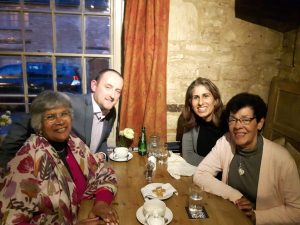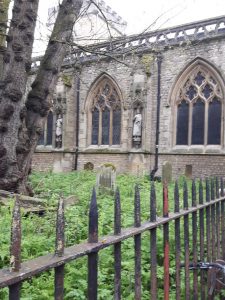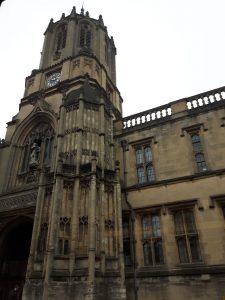Day 3
I must reminisce here and recall the symphony of bird song outside my bedroom window, and indeed, hearing birds singing where ever we went during our stay. I looked down in the garden and thrilled to see, finches, robins, which are very small in England, hedge sparrows, and other tiny birds. Then a magpie flew down onto the grass. Do you know dear reader magpies are big birds, and black and white, Wood pigeons also flew in and out of the garden, and at times strutted about in the grass-very green grass. They are plump birds with pretty plumage, gray and white, with splashes of orange and brown. On some hanging plants in the garden, a rook determinedly pulled at the straw layer that coated the plant holder. It managed to fly off with a large amount in its beak. Further, a field I saw kites soaring above the trees; that is the bird type with their distinctive forked tails.
The day was overcast and cold, but undaunted Pearl and I set out for Oxford, winding out of the village, where every garden shouted Spring is here! Daffodils, buttercups, primroses, forsythia, and a host of budding trees delighted the eye. Pearl casually mentioned, “That’s Mary Berry’s house.” Mary is a household name in England, and she has appeared on many cooking shows. A little further along, we drove passed Blyton Road, named after Enid, who lived in Tyler’s Green. Later I learned William Penn also hailed from the area. There is a Penn house, still occupied by his descendants. And then there is Pennsylvania in the states, where Quakers from the village settled. They didn’t all leave, there is a Quaker meeting house in Tylers Green, with a notice on the door, saying, ‘all are welcome.’
We drove on to a Park n’ Drive and bussed into Oxford. The town was filled with people. We found our way to the visitors centre and bought tickets to take a bus tour around the city. Before embarking on the tour, we settled for an Italian restaurant named Bella Italia, to have lunch. We were not too hungry, but enjoyed a delicious lentil soup with crusty bread, served to us by an Italian waitress, who greeted us with ‘Buon Giorno signore.’
Once on the tour bus, we enjoyed the excellent commentary, and we learned some interesting facts. Stone age inhabitants lived there before the last ice age. Bronze and Iron Age remnants have been excavated. (Of course, this is typical of many areas in Britain).
Most of the streets in historic Oxford are part of the grid laid out by the Saxons over a 1000 years ago.
(Source: A Brief History of Oxford. Phil Opher.)
Oxford, through the ages, has gone through many phases, some good and some bad, with different factions fighting for dominance. Three Protestant bishops were burned at the stake there as heretics, Bishops Latimer and Ridley in 1555, and Archbishop Cramer in 1556. Today a memorial stands in the city centre in their honour. It is impossible to give a historical account of Oxford. I had heard and read, that Edward the Confessor founded the first colleges there, but reading the History of Oxford, he is not even mentioned! However, of interest are the spires. Matthew Arnold, a poet and English critic, dubbed the historical buildings, The Dreaming Spires. Of importance too is the fact that each college, of which there are many, is independent of the other.
At one stage, a fight ensued between the students of Oxford over some administration issues. The argument so severe that one faction packed their bags, left, and started another college – Cambridge! There remains some serious rivalry to this day between the two institutions when every Spring the Oxford and Cambridge boat race takes place on the River Thames and is a nationally televised event.
Riding through the city, the commentator pointed out the pub where C.S Lewis, JRR Tolkien, and Charles Williams frequently met. Together they were known as The Inklings. Although other academics also joined the Inklings as time went on.
Our tour ended, and we chose, because of the cold, to go to Boswells, a delightful upscale store with a café on the second floor. Here we sat and warmed ourselves with hot chocolate and toasted buttered teacakes. Browsed some gift shops and purchased a few items.
We made our way back to Park n’ Drive, got in the car and drove to Burford in the Cotswolds, to meet Helen, Pearl’s younger daughter, and her husband, Dan, for dinner. They were coming straight from work. It meant that each of our travelling time was about an hour. We passed many a green meadow with sheep grazing.
‘The Cotswolds lie across the boundaries of several English counties; mainly Gloucestershire and Oxfordshire, and parts of Wiltshire, Somerset, Worcestershire and Warwickshire. The area is defined by the bedrock of Jurassic limestone that creates a type of grassland habitat rare in the UK and that is quarried for the golden coloured Cotswold stone.[2] It contains unique features derived from the use of this mineral; the predominantly rural landscape contains stone-built villages, historical towns and stately homes and gardens. The population of the District is about 84,000.’ {Source: Wikipedia)
We dined at The Royal Oak Pub in Burford. Our dinner was delicious. Pearl & I had fish cakes and a delicious green salad. Helen & Dan opted for chicken and ham pie, chips, and greens vegetables. The pub is a 15th-century building with stone walls, wooden rafters, and a crackling log fire. Our waiter told us Charles 11 had courted Nell Gwynne in the upstairs apartments! There is not a place in England where a soul can go and not find or hear of some marvellous piece of history.
September 3rd, 1651 the Royalists were defeated in the battle of Worcester. Charles 11 hid in a nearby oak tree, and when the coast was clear escaped to France.
Eventually Oliver Cromwell’s armies were defeated, and England welcomed the return of Charles and the monarchy. His father, Charles 1st, had been executed years before for his insistence that the king had the right to rule and govern parliament.
We drove back to Tylers Green in the rain!



